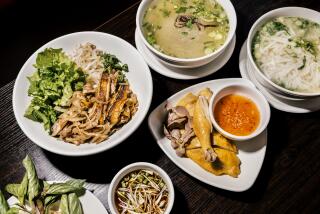Vietnam Exploits a Golden Opportunity
HANOI â By 5 p.m., with offices and factories emptying for the day, Bui Ngoc Vinhâs beer garden is packed. Nearly all the 50 or so tables are full, peanut shells are starting to litter the cement floor, and the atmosphere is thick with cigarette smoke and congenial chatter.
âIt should be an early night,â Vinh says, as waitresses scurry among the tables of mostly male drinkers, balancing trays of 13-cent beer and snacks of dried squid and fermented pork sausage known as nem chua. âI imagine weâll run out of beer by 8, 8:30 at the latest.â
Like other proprietors of pubs tucked in courtyards and storefronts and on sidewalks in Hanoi, Vinh opens at 9 a.m. and closes when he runs out of beer--which he does almost every evening.
His brisk sales are testimony to the Vietnamese passion for beer, one of many emerging consumer markets in this country that have caught the attention of foreign investors. They also point to the popularity of the bia hoi, a Hanoi institution that is as much a part of the cityscape as honking horns, sidewalk noodle stalls and peddlers with baskets of warm bread.
Bia hoi, meaning fresh beer, refers both to establishments such as Vinhâs and to the special brew he serves: a light, low-carbonation beer that is not chemically treated and has a shelf life of only two or three days. Bia hoi is served chilled--but not frosty cold--and comes in 10-gallon kegs like draft beer.
The aluminum barrels, known as bombs, start rolling down ramps at Hanoi Brewery shortly after dawn each day. They are soon on their way to the thousands of bia hois scattered throughout Hanoi. Some, including Vinhâs establishment, are owned by the central government; others are private enterprises.
According to government statistics, the 77 million Vietnamese drink five times more beer than they do fresh milk. Still, on a per capita basis, their annual beer consumption is modest--something less than two gallons, compared with 31 gallons in the United States.
One reason: Beer is a perk of life enjoyed in the more prosperous cities. In the impoverished countryside, where most Vietnamese live, beer--even at 13 cents a glass--is beyond financial reach.
Despite that, beer offers a promising consumer market: Sales by volume are growing 18% a year. Nearly a dozen foreign brewers--including Heineken (Netherlands), Carlsberg (Denmark) and Tiger (Singapore)--operate in Vietnam.
The government here, with an eye on the export market, is eager to promote its state-owned beer and cigarette industries. But bia hoi remains a domestic drink because of its short shelf life, and Vietnamâs premium bottled beers--such as 333, produced by the Saigon Brewery--have not found a large export market.
Still, foreign brewers consider Vietnam one of Southeast Asiaâs most promising long-term markets. Vietnam is not predominantly Muslim, as are Indonesia and Malaysia. It is not dominated by one brand, as is the Philippines with San Miguel. It is not saturated with dozens of foreign labels, as is Singapore. And Vietnam has no set closing time for bars and no minimum age for drinking--although alcohol abuse is rare among teenagers.
Although Ho Chi Minh City--the former Saigon--also has bia hoi pubs, Hanoians point out that their bia hois--in terms of abundance and significance as gathering places--have always been a trademark of the north.
The state took over all breweries in 1975. For many years, beer--like other commodities--was rationed through the issuance of coupons, and only the Hanoi and Saigon breweries survived. That changed dramatically with Vietnamâs gradual move toward a free-market economy in 1989, and today more than 300 breweries operate throughout the country.
âThe market is much more competitive now,â says Vinh, who has upgraded his menu and installed a bright yellow awning over the beer garden.
âYou have to provide a better atmosphere now to keep your customer,â he says. âYou have to be sure the waitresses are friendly, the food is good and that people feel comfortable so they want to come back, instead of going to another bia hoi across the street.â


